Northwest Territories' territorial symbols
The most populous territory in northern Canada, the Northwest Territories are bordered by Canada’s two other territories – Nunavut to the east and Yukon to the west.
Origin of the name
Most of the Northwest Territories were known as the North-Western Territory until 1870. Then as now, the name is primarily descriptive of the location of the Territories.
Population (2006): 41,900
Total area: 1,171,918 km2 Capital: Yellowknife Date of creation: July 15, 1870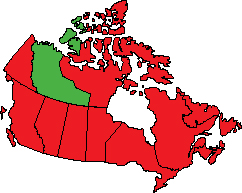
History
The Northwest Territories were inhabited by Inuit and First Nations peoples long before the Europeans arrived in search of the elusive Northwest Passage. Native Inuit included the Mackenzie, Copper, Caribou and Central nations. There were also many nations when the Europeans first arrived, among them the Yellowknives, Chipewyan, Sekani, Beaver, Nahanni, Dogrib and Slavey. Some nations in the area spoke a form of the Athapaskan language, the only native language in North America to have traces of an Asiatic origin.
The first European explorers were the Vikings, who sailed to the Eastern Arctic about 1000 AD. However, Martin Frobisher’s expeditions in the 1570s were the first recorded visits to the Northwest Territories by an explorer. In 1610, while looking for the Northwest Passage, Henry Hudson landed briefly on the western shore of the bay that bears his name. His discovery opened the interior of the continent to further exploration.
By the 1700s, the Northwest Territories were dominated by two fur trading companies: the Hudson’s Bay Company, based in London, England, and the North West Company, based in Montréal.
In 1870, the British government transferred control of the North-Western Territory to Canada, and the Hudson’s Bay Company sold Rupert’s Land to the new dominion for 300,000 pounds sterling. The combined area was renamed the Northwest Territories. Ten years later the British government transferred the islands of the Arctic archipelago to these territories.
At some time in their history, the Northwest Territories have included all of Alberta, Saskatchewan, Yukon, and most of Manitoba, Ontario and Quebec.
In 1870, the original tiny province of Manitoba was carved out of the area. In 1905, both Alberta and Saskatchewan were created from the Territories. Manitoba was increased in size in 1881 by taking land from the Territories. In 1898, Yukon became a separate territory, while the provinces of Manitoba, Ontario and Quebec were enlarged by taking land from the Territories in 1912. Even with this loss of land, the Northwest Territories remained Canada’s largest political subdivision (with just over a third of the country’s total area) until 1999.
In April 1999, the Northwest Territories was divided in two, with 60 percent of the land being transferred to the new territory of Nunavut in Canada’s Eastern Arctic.
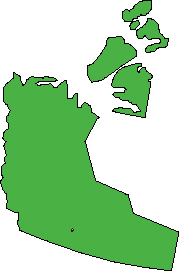
Coat of arms
The Northwest Territories’ coat of arms was granted by Queen Elizabeth II in 1956 and represents the geography of the Northwest Territories at that time. The white upper third of the shield represents the polar ice pack and is crossed by a wavy blue line that symbolizes the Northwest Passage. The lower portion is divided diagonally by a wavy line that represents the treeline; the green stands for the forested areas south of the treeline, and the red represents the tundra to the north.
Minerals and fur, the foundation of northern wealth, are represented by gold billets in the green section of the shield and the face of a white fox in the red section. The crest includes two narwhals, and the compass rose between them represents the North magnetic pole.
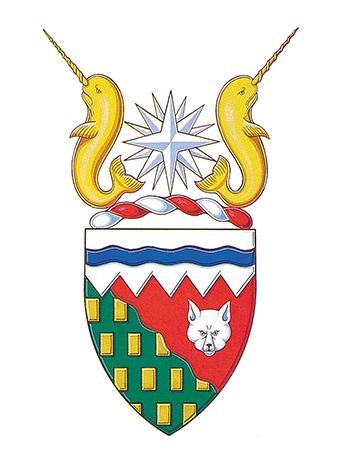
Flag
The flag of the Northwest Territories was adopted by the territorial council in 1969 following a nationwide design competition won by Robert Bessant of Margaret, Manitoba. The blue panels at either end of the flag represent the lakes and waters of the Territories. The white centre panel symbolizes the ice and snow of the North and contains the shield of the territorial coat of arms. The flag’s proportions are two by length and one by width.
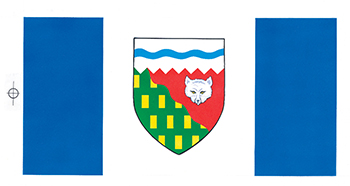
Floral emblem
The Northwest Territories’ floral emblem, the mountain avens (Dryas octopetala), was adopted in 1957. The creamy-white flower, which is a member of the rose family, grows in the Eastern and Central Arctic on high, barren rocky ground. It has narrow basal leaves, and supports a single bloom on a short stem.
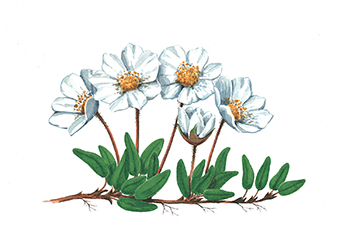
Other territorial symbols
Bird
Adopted in 1990 as the Northwest Territories’ official bird, the gyrfalcon (Falco rusticolus) is the largest of the falcons. It is sleek, fast and strong, and can be found almost anywhere in the Territories. Although gyrfalcons can range in colour from white to grey, brown or black, the darker birds are more common in the tundra regions.
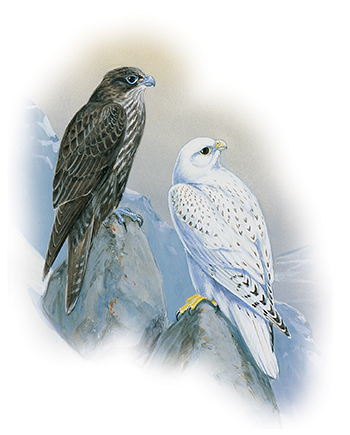
Fish
The Arctic grayling (Thymallus arcticus) was named the official fish of the Northwest Territories in 1999. It has the ability to live in the harshest environments and can be found in a broad range of habitats in the Northwest Territories.
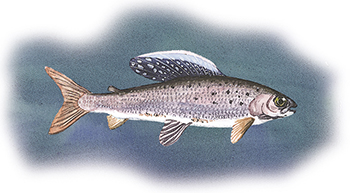
Gemstone
The diamond was adopted as the official gemstone of the Northwest Territories in 1999, to recognize that it is home to Canada’s first diamond mine.
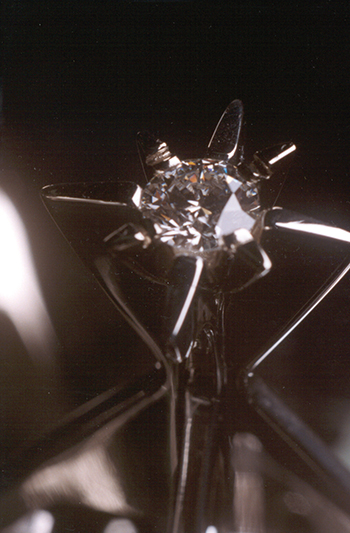
Mineral
In 1981, gold was proclaimed as the mineral emblem for the Northwest Territories. Historically, gold has played a major role in the development and prosperity of the area. It symbolizes the enduring value of wealth and the bright prospects and future of the Northwest Territories.
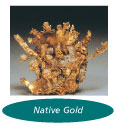
Tartan
The idea for the Northwest Territories’ tartan was proposed by Janet Anderson-Thomson, a long-time resident. Upon her suggestion, research was carried out and an original design was developed and produced by the firm of Hugh MacPherson (Scotland) Limited, of Edinburgh, the leading designer of tartans in the world. The tartan was unveiled at the 48th Session of the Territorial Council in January of 1973, and includes many colors of the North: the white of the snow; the green of the forests; the yellow of the birches in fall; the red of the tundra; and the blue of the lakes, rivers and oceans. The tartan is registered at the Court of the Lord Lyon, King of Arms of Scotland, and anyone may wear it.
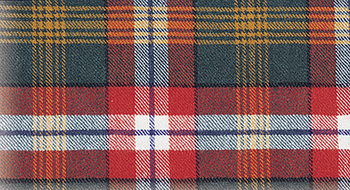
Tree
The tamarack larch (Larix laricina) replaced the jack pine as the Territories’ tree symbol in 1999. The tree grows to 15 metres (49 feet) and it is a prime source of wood for poles and posts.